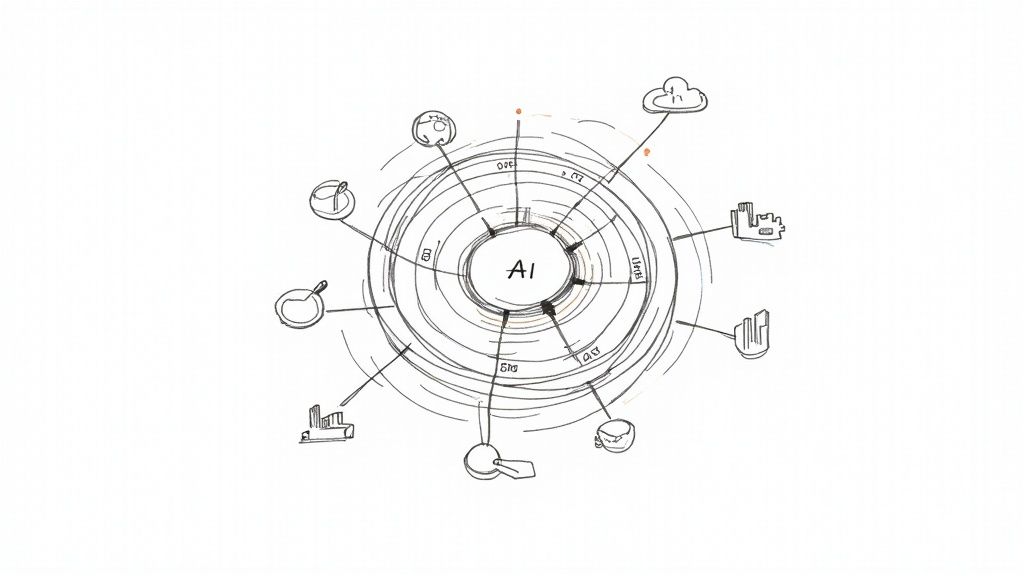AI Strategy for Businesses: Essential Guide to Success
Master AI strategy for businesses with proven frameworks that deliver real results. Learn from industry leaders who've transformed their operations.

Understanding AI Strategy: More Than Just Technology
Building an effective AI strategy is like planning a successful road trip. Think of AI as your vehicle - it's powerful, but useless without three key things: 1) A clear destination (your business objectives), 2) A well-planned route (your implementation strategy), and 3) Knowledge of traffic laws (your governance framework). Too many companies invest in the AI 'vehicle' first, only to find themselves lost without these essential elements.
A real AI strategy for businesses is a roadmap that weaves artificial intelligence into your company's core to reach specific, measurable goals. It pushes past isolated experiments and forces you to answer the big questions: why, where, and how will we use AI? This alignment is essential; while over 60% of companies are using AI, many without a clear plan are struggling to see a real return on their investment.
AI Strategy vs. Traditional IT Projects
It's easy to think of an AI project as just another software rollout, but that's a common and costly mistake. Traditional IT projects typically have a defined start, a clear finish, and predictable outcomes. AI initiatives are a completely different animal.
Here are the key differences:
- Continuous Evolution: An AI model is not a piece of software you install and forget. It needs constant attention—monitoring, retraining with fresh data, and adjustments—to prevent its performance from degrading. Think of it as a garden that needs regular tending, not a tool you put back in the box.
- Data as the Core Asset: A successful AI business strategy treats data as its most valuable resource, not just an operational byproduct. The success of any AI model depends entirely on the quality and accessibility of your data, far more than the algorithm itself.
- Deep Cultural Integration: Installing new software is mostly a technical task. Weaving AI into your business, however, requires a major cultural change. It affects job roles, skill sets, and how decisions are made, demanding a company-wide willingness to trust data-driven insights.
The Foundational Mindset Shift
Ultimately, a working AI strategy starts with a new way of thinking, from the top down. It requires moving from using AI for simple task automation to seeing it as a way to reinvent the business entirely. Leaders who succeed don't just assign AI to the IT department; they champion it as a central part of the company's future.
This new mindset looks beyond a single "killer app." It explores how multiple AI functions can work in concert to redesign entire processes, from personalizing the customer journey to untangling complex supply chains. The ultimate goal is to build an organization that learns and adapts faster than its competitors, creating a lasting advantage that's difficult for others to copy.
The Current AI Landscape: Why Businesses Are Racing Forward

The conversation about Artificial Intelligence has moved from the boardroom to the production floor. The race to get real business value from AI is happening now, with many organizations moving it from a theoretical idea to a practical tool. In fact, more than 60% of companies have gone beyond the testing phase and are actively using AI in their daily operations.
This isn't a random push. It's a calculated move toward measurable results, and businesses with a clear AI strategy for businesses are taking the lead.
The Accelerating Pace of Adoption
The speed of AI integration is impressive. Companies that set a clear vision for AI see returns on their investment much faster than those with a scattered approach. This global trend is mirrored right here in the Netherlands, where the local AI market is on a steep upward path. Projections show it reaching a market size of $2.38 billion by 2025.
This growth is fueled by progress in machine learning, natural language processing, and especially generative AI. Dutch businesses are showing a strong interest in using these tools for customer support and service automation. See the full market growth details here.
This rapid adoption is happening across all industries. From finance and retail to manufacturing and healthcare, companies realize that standing still is a competitive risk. The worry is no longer about the cost of investing in AI, but the cost of being outpaced by competitors who do.
Key Drivers Fueling the AI Boom
This major investment is not happening without reason; it's driven by obvious and quantifiable business benefits. Companies are moving quickly because AI delivers results that directly affect their bottom line and market position. A solid AI strategy for businesses typically focuses on three core drivers:
- Operational Efficiency: Think of AI as an incredible assistant for your workforce. It automates boring, repetitive tasks, which frees your team to concentrate on complex problem-solving and creative work. This results in fewer mistakes, quicker processes, and notable cost savings in areas from data entry to supply chain management.
- Superior Customer Experiences: In a full market, personalization matters. AI can analyze huge volumes of customer data in real time to provide specific recommendations, predict needs, and offer instant support through intelligent chatbots. This creates a more connected and pleasing customer journey that builds loyalty.
- Strategic Competitive Advantage: This is the ultimate goal. An effective AI strategy supports data-informed decision-making at a speed and scale that is simply impossible for people. It’s like having a team of analysts working 24/7 to spot market trends and find new opportunities. Companies without this are essentially competing with a blindfold on.
Ultimately, the race to implement AI is a race for relevance. The question for business leaders is no longer if they should adopt AI, but how quickly they can build a strategy to make it a core part of their success.
Building Your AI Strategy Framework: Vision to Execution
Think of an effective AI strategy as an architectural blueprint. You wouldn't build a skyscraper without a solid foundation, a detailed plan, and a skilled construction crew. Similarly, a successful AI strategy for businesses needs a structured framework that connects your high-level vision to the actual work on the ground.
Start with Why: Aligning AI with Business Objectives
The first and most critical step is to tie every potential AI initiative directly to your core business goals. AI is a powerful tool, but it's not the end goal itself. Without this clear alignment, you risk investing in impressive technology that doesn't actually improve revenue, efficiency, or customer satisfaction.
A great way to achieve this is through a combined top-down and bottom-up approach. Leadership sets the overall direction: the "why", while individual teams identify practical, day-to-day problems that AI can solve. This ensures your strategy is both ambitious and grounded in reality. While only 35% of companies have a formal AI strategy, those that do are far more likely to see a positive return because they start here.
This diagram illustrates how business goals should flow down to specific AI projects, not the other way around.

The key takeaway is that technology choices should be the final step. This hierarchy ensures you're solving a business problem with technology, not looking for a problem to fit your new tech.
To put this into perspective, the table below breaks down the core components of a solid AI strategy framework.
Framework Component
Priority Level
Timeline
Key Success Factors
Business Vision Alignment
High
0-2 Months
Clear leadership buy-in; direct connection to company KPIs.
Use Case Identification
High
1-4 Months
Cross-functional team input; balanced value vs. feasibility scoring.
Data Readiness & Governance
High
Ongoing
Accessible, high-quality data; defined data ownership and privacy.
Technology & Infrastructure
Medium
3-9 Months
Scalable architecture; compatibility with existing systems; strong security.
Execution Roadmap
Medium
4-18+ Months
A mix of quick wins and long-term projects; agile development cycles.
As the table shows, success starts with high-priority strategic decisions before moving into technology and execution. This staged approach prevents costly mistakes and helps build momentum over time.
From Vision to Value: Identifying High-Impact Use Cases
Once your "why" is clear, the next challenge is to decide where to apply AI. The possibilities can feel endless, so the goal is to filter a long list of ideas into a short, prioritized set of projects. A proven method is to evaluate each potential use case across two dimensions: business value and feasibility.
This evaluation helps you find the sweet spot between what's possible and what's profitable. For each potential project, ask:
- Business Value: How much will this project improve our key metrics? Does it directly support our main company goals?
- Feasibility: Do we have the necessary data to make it work? How complex is the technology involved? Can our team realistically adopt and use this new tool?
For example, a Dutch e-commerce company might consider a recommendation engine (high value, high complexity) or an AI tool to predict customer churn (high value, moderate complexity). By assessing feasibility, they might find the churn model is a better initial project because its data is more accessible and its technical needs are lower, offering a faster path to generating value.
Creating Your Roadmap: Balancing Quick Wins and Long-Term Goals
With your best ideas prioritized, the final piece of the puzzle is to assemble them into a realistic roadmap. A strong AI strategy for businesses is a journey, not a single destination. Your roadmap must sequence initiatives to build momentum, show value early, and manage risk. This requires a careful balance of two types of projects.
- Quick Wins: These are lower-risk projects that deliver measurable results within a few months. An example is using an AI tool to automate invoice processing, which can show immediate cost savings. These victories are essential for building organizational buy-in and justifying future investment.
- Long-Term Goals: These are ambitious projects that aim for fundamental business transformation. They might involve redesigning a supply chain with predictive analytics or creating an entirely new AI-driven product. While they take longer, they offer the most significant and lasting competitive advantage.
Your roadmap plots these initiatives on a timeline, turning a grand vision into a series of manageable steps. This structured plan provides a clear path from a small pilot project to enterprise-wide impact, ensuring your AI strategy delivers real results.
Overcoming Implementation Challenges That Trip Up Most Companies

Even the most detailed plan for bringing AI into your business can hit snags. It's a lot like starting a major home renovation. You have the blueprints, but the moment you tear down a wall, you might find faulty wiring or a weak foundation you never knew existed.
For companies, these hidden problems are the implementation hurdles that can stop a strong AI strategy for businesses in its tracks. Knowing what to look for is the best way to keep your project moving forward.
The Data Quality Dilemma
The most frequent and serious obstacle is poor data. Think of an AI model as a highly trained chef. No matter how skilled they are, they can't create a gourmet meal with spoiled or low-quality ingredients. If your company’s data is disorganized, incomplete, or locked away in separate departmental systems, your AI will deliver inaccurate or biased outcomes.
This is the classic "garbage in, garbage out" scenario, and it can weaken your entire effort. The solution is to invest in data governance before you try to expand your AI projects. This means taking practical steps:
- Cleaning and standardizing data across the company to ensure everyone works from the same information.
- Breaking down data silos to let information move freely between departments like marketing, sales, and operations.
- Establishing clear ownership and security rules to protect data integrity for the long run.
When you treat data as a core business asset instead of a technical detail, you give your AI the clean fuel it needs to work properly.
Bridging the Talent and Skills Gap
Another significant challenge is finding people with the right AI skills. You can have the best technology and the cleanest data, but without a team that knows how to apply them, you won't make much headway. This isn't just about hiring specialized data scientists; it also means training your current employees to work comfortably with new AI tools and processes.
This is a common issue, even in places with high AI adoption. For example, businesses in the Netherlands are adopting AI at a faster rate than the European average, with around 49% on board compared to the EU’s 42%. Despite this, many of these companies point to a lack of digital skills and questions about regulations as major roadblocks. You can find more details on Dutch AI adoption trends here.
The answer lies in a two-part approach: making strategic hires for very specific roles while also investing in company-wide training programs to raise everyone's AI knowledge.
Navigating Cultural and Organizational Resistance
Finally, the technology is only one piece of the puzzle; the human side can be the most difficult to manage. Employees might push back against AI because they fear their jobs are at risk or simply don't trust decisions made by an algorithm. If your team doesn't understand or buy into the AI tools, they won't use them, and the entire investment will be for nothing.
Creating a culture of trust is essential. This starts with leadership communicating openly about how AI will support employees in their roles rather than replace them. Running small, successful pilot projects can also provide tangible proof of AI's benefits in a low-risk environment.
Effective change management helps turn doubters into supporters and gets the whole organization aligned. A successful AI strategy for businesses is just as much about guiding people as it is about managing technology.
Measuring Success: ROI Metrics That Actually Matter
After the hard work of implementing your new AI system, the crucial question hangs in the air: was it worth it? An effective AI strategy for businesses needs a solid way to measure its impact, both to guide future investments and to prove its value.
Relying on a traditional Return on Investment (ROI) calculation is like judging a new highway system only by the price of the asphalt. This view misses the most important benefits: faster commutes for everyone, new economic growth along the route, and far less congestion. To truly understand your AI's value, you must look beyond the initial spend and measure its full effect on your business.
Expanding the Definition of Return on Investment
A true measure of AI success captures both quantitative and qualitative returns. The quantitative side is more straightforward, focusing on direct financial gains and cost reductions. These are the hard numbers that appear on a balance sheet, like lower operational expenses from automating repetitive tasks or increased sales from a smarter recommendation engine. These metrics are vital for securing budgets and demonstrating immediate value.
However, the qualitative impacts are often where the deepest competitive advantage lies. These are improvements that are harder to assign a specific dollar value to but are critically important. For example, consider the speed and quality of decision-making. When AI gives managers clearer insights, they can make better strategic choices, faster. It also includes gains like improved team morale as tedious work disappears or an increased capacity for strategic thinking. A complete measurement plan tracks both.
Key Performance Indicators for Your AI Dashboard
To manage these varied metrics, successful companies create a centralized AI performance dashboard. This provides a single view of how initiatives are performing against their goals, making it easier to communicate progress across the organization. Think of this as your mission control, with essential Key Performance Indicators (KPIs) tailored to specific business functions.
Here is an example of what an AI Performance Metrics Dashboard might look like. It outlines key performance indicators for measuring AI strategy success across different business functions, helping to connect technology outputs to business outcomes.
Business Function
Primary Metrics
Success Benchmarks
Measurement Frequency
Operations
Cost reduction per process; Cycle time reduction; Decrease in manual error rates.
Achieve 15% cost savings in Q1; Reduce production time by 20%.
Monthly
Customer Service
Average support ticket resolution time; Customer Satisfaction (CSAT) scores; AI chatbot containment rate.
Improve CSAT by 10 points; Increase chatbot resolution by 25%.
Weekly
Marketing
Lead conversion rate from AI-powered campaigns; Customer Lifetime Value (CLV); Marketing ROI attribution.
Lift conversion rates by 5%; Increase attributed CLV by 12%.
Bi-weekly
Strategic
Time-to-market for new products; Employee satisfaction in AI-assisted roles; Rate of successful innovation projects.
Launch products 30% faster; Improve employee retention by 5%.
Quarterly
This table shows how different parts of a business can track success in a way that makes sense for their specific goals. From monthly cost checks in operations to weekly customer satisfaction scores, each metric is tied to a clear benchmark.
This focus on a broad spectrum of metrics is not just theoretical; it translates into real, measurable growth. This rapid adoption has led to tangible benefits, including average revenue increases of 27% for companies using AI. Around 88% of these businesses report direct benefits from AI implementation, such as improved productivity and customer engagement. Discover more insights on AI adoption benefits here.
Ultimately, measuring success is an ongoing process, not a one-time report. The KPIs on your dashboard provide the data needed to refine your models, adjust your goals, and identify new opportunities for AI to create value. This continuous feedback loop is precisely what sustains a successful AI strategy for businesses, turning it from a simple technology project into a core engine for growth and adaptation. By proving what works and learning from what doesn’t, you can justify continued investment and ensure your AI initiatives deliver a lasting competitive edge.
Real-World Success Stories: Learning From AI Leaders
Theory provides a great starting point, but the most valuable lessons come from seeing how real companies put AI to work. The best AI strategies aren't developed in a vacuum; they are shaped by the need to solve specific, pressing business problems. Let’s look at how leaders, both large and small, have turned their plans into tangible successes.
The Enterprise Blueprint: Optimizing a Complex Supply Chain
Imagine a large logistics company in the Netherlands responsible for thousands of daily deliveries. Their core challenge was inefficiency. Unpredictable traffic, volatile fuel prices, and routes that were far from perfect were shrinking profits and causing package delays. Their ai strategy for businesses didn't start with technology; it started with this very specific pain point.
They introduced an AI system that used predictive analytics to process real-time traffic information, weather forecasts, and historical delivery data. The system didn't just create a static route plan; it learned and adapted throughout the day as conditions changed. The results were undeniable: a major drop in fuel usage, more precise delivery estimates, and a noticeable rise in customer satisfaction. This shows how AI can be applied to a single operational hurdle to achieve significant gains.
The Local Innovator: Personalizing the Customer Journey
AI is not reserved for corporate giants. Consider a mid-sized e-commerce retailer in Amsterdam that needed to compete with much larger global players. Their main challenge was standing out and encouraging repeat business. They built their strategy around creating a highly personal shopping experience. By using an AI-powered recommendation engine, they could show customers products they were truly likely to purchase, moving beyond generic "best-seller" lists.
This practical application of AI is becoming more common. Across the Netherlands, the business community is increasingly adopting these tools. By 2024, approximately 22.7% of companies with ten or more employees were using artificial intelligence, marking a sharp increase. You can explore the details on Dutch AI adoption to see the full picture. For the retailer, this meant better conversion rates and more loyal customers.
These two stories, while different in scale, highlight a shared formula for success. Effective leaders don't view AI as a cure-all. Instead, they stick to a clear and disciplined pattern:
- Problem-First Approach: They identified a specific, high-value business problem before ever discussing technology.
- Focused Implementation: They began with a well-defined scope, targeting a single process like logistics or customer recommendations.
- Measurable Outcomes: They defined what success looked like—reduced costs, higher satisfaction, increased sales—and tracked it relentlessly.
This structured method is the foundation of any AI strategy for businesses that generates lasting value.
Your AI Strategy Action Plan: Next Steps for Success
An idea only has power when you put it to work. Turning the frameworks and concepts we've discussed into real action is the final, and most crucial, step. This guide offers a clear path to take your AI strategy for businesses from a document to a living part of your daily operations.
Phase 1: Establish Your Foundation (0-3 Months)
The first 90 days are about creating a solid base for all future AI work. The aim isn't to overhaul the entire company at once, but to achieve a focused, successful first win that builds essential momentum. Begin by putting together a small, cross-functional team with people from business, operations, and technology.
With your team ready, the main task is to select a single pilot project. Look for an initiative that promises a clear victory with manageable complexity—for example, solving a specific bottleneck in your operations. To ensure everyone is accountable, define what success looks like with precise metrics before you start.
- Target KPI: What specific number will you improve? (e.g., reduce support ticket response time).
- Success Benchmark: By how much? (e.g., a 15% reduction).
- Required Resources: What data, tools, and people are needed?
The field of artificial intelligence is enormous, with applications from machine learning to natural language processing, as shown in the diagram below.
This wide scope can feel like a lot to handle, which is why a focused pilot project is so important for making tangible progress.
Phase 2: Build and Learn (3-9 Months)
This next phase is all about execution. With your pilot project defined, the following six months are for building the solution, deploying it in a controlled environment, and collecting data. This is where your AI strategy for businesses meets the real world. Communication is vital; use a simple dashboard to report on your pre-defined KPIs to stakeholders, which maintains transparency and manages expectations.
Once the pilot is over, the most important activity is a deep review. Your team should analyze what worked, what didn't, and why. This isn't about passing judgment but about generating critical lessons for the future.
- Did we hit our benchmark?
- Was our data good enough?
- What was the actual user feedback?
- The documented answers become the business case for your next AI project.
This repeating cycle of piloting, measuring, and learning makes AI implementation less mysterious. It turns a large, abstract goal into a series of manageable projects that build on one another, ensuring your strategy delivers consistent results over time.
This disciplined process can feel demanding. If you want to speed up your journey from idea to impact without the guesswork, ekipa.ai can help. We deliver an actionable AI strategy in 24 hours, uncovering your company’s opportunities and providing a clear execution plan.
Start your AI transformation with Ekipa.ai today.



